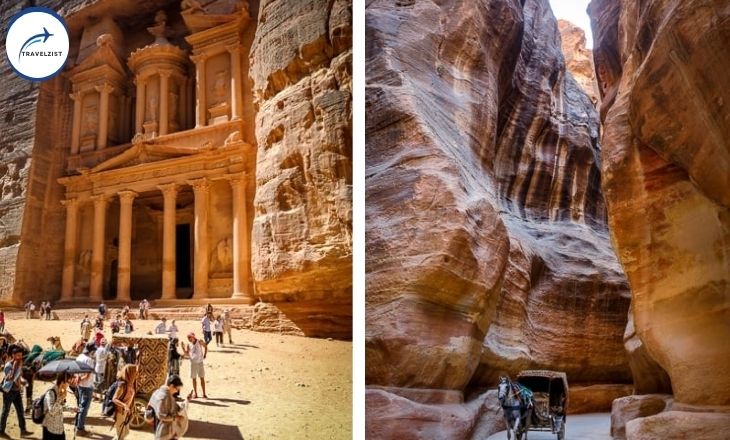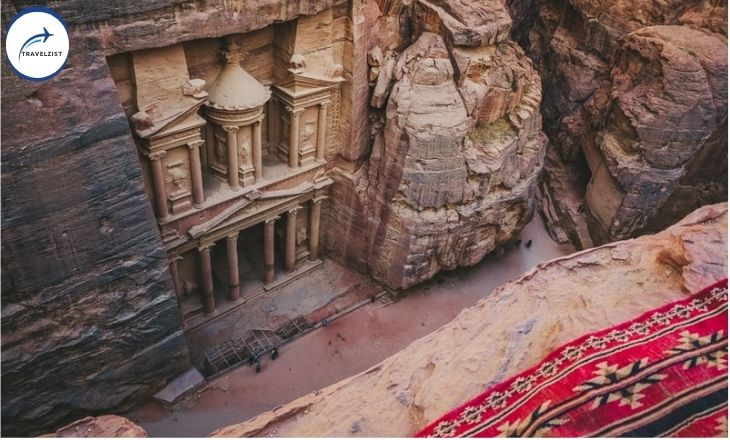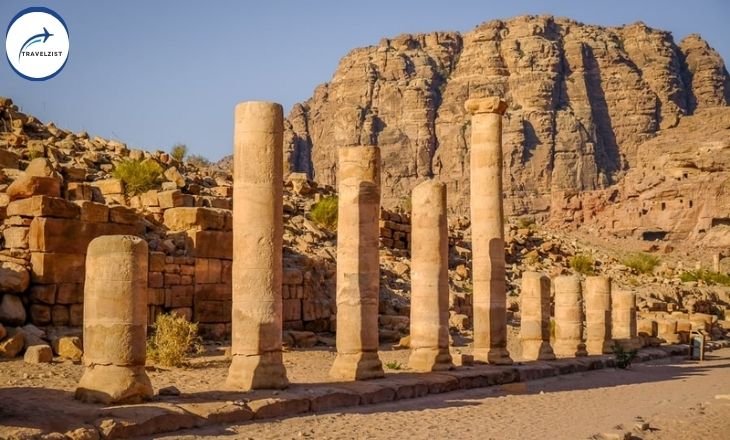The lost city of Petra is located in the desert canyons of southern Jordan. It is an ancient marvel of architecture and history. As you explore this Petra Jordan Travel Blog & Map, you will be taken back in time to a grand and mysterious era. The rose-red sandstone cliffs hold many archaeological wonders, each telling a story of the Nabatean civilization.
This travel blog will uncover the secrets and legends surrounding this mysterious site, giving you insights into its historical significance and practical tips for navigating its pathways. Join us on an unforgettable expedition through the heart of The Lost City Petra.
What Is Petra Jordan? What Is The History?
Petra is an old city in southern Jordan known for its impressive rock-cut buildings and historical importance. It became the capital of the Nabatean Kingdom around 312 BC and was a major trading center because of its location on ancient trade routes. The most famous structure in the city is the Treasury, carved into the rose-red cliffs.
It is a popular tourist spot and a UNESCO World Heritage Site. Petra has a diverse history, influenced by the Nabateans, Romans, and Byzantines. It started to decline in the 7th century AD and was forgotten until it was rediscovered by Swiss explorer Johann Ludwig Burckhardt in 1812.
Day Tours To Petra Jordan:
Many people take day tours to Petra, Jordan to see the old city’s amazing buildings and learn about its history. Tour companies offer guided trips from nearby cities like Amman or Aqaba, providing transportation, entrance fees, and knowledgeable guides.
These tours usually include visits to famous sites like the Treasury, the Monastery, and the Royal Tombs, so visitors can see the best of Petra in just one day.

Where Is Petra Jordan?
Petra is an old city in southern Jordan, near Wadi Musa. It was carved into pink rock cliffs and used to be the Nabatean kingdom’s capital. The site is known for its impressive rock-cut buildings and water systems.
It is a UNESCO World Heritage Site and one of the New Seven Wonders of the World. Visitors can explore the narrow canyon called the Siq, which leads to the famous Al-Khazneh (The Treasury) building, as well as many tombs, temples, and other structures carved into the cliffs. Petra is a must-see for history fans and travelers interested in ancient civilizations.
How To Get To Petra Jordan?
To get to Petra, Jordan, you can fly into Queen Alia International Airport in Amman, which is the closest major airport. From there, you can take a taxi or arrange for a private transfer to Petra, which is about a 3-hour drive. Once in Petra, you can explore the petra ancient city on foot or hire a local guide. The main entrance to Petra is through the Siq, a narrow gorge that leads to the iconic Treasury building.
Private Taxi
Private taxis may cost more than other transportation options, but they offer a personalized and efficient way to travel in Petra, so you can make the most of your time exploring this amazing place.
JETT Bus
The JETT Bus is a popular way to travel to Petra, Jordan. It offers comfortable and reliable transportation from different places in Jordan to Petra. The buses have air conditioning and provide a safe way to reach this historic site.
Traveling by JETT Bus to Petra is affordable, with regular departures from Amman and other major cities in Jordan. The journey offers scenic views of the Jordanian landscape and a chance to relax and enjoy the historically rich region.
Rental Car
You can find many car rental companies in Petra that offer different types of vehicles. Renting a car allows you to make your own travel plans and visit places like Wadi Rum or the Dead Sea.
It’s important to learn about local traffic laws and road conditions before you start driving in Jordan. You should also think about getting good insurance for your rental car. Renting a car in Petra can make your trip better by letting you explore Jordan at your own pace.

Map Of Petra:
When you go to Petra, Jordan, you need a map to find your way around. The most important place in Petra is the Treasury, which is at the end of the Siq, a narrow gorge that is the main entrance. After that, you can see the tombs, temples, and other structures carved into the rock.
There are also hiking trails in Petra, including ones to the Monastery and High Place of Sacrifice. These trails have great views and are good for exploring. A detailed map of Petra will help you make the most of your visit and see all the amazing sights.

Visiting The Ancient City Of Petra:
Visiting Petra is an amazing experience that shows the history and architecture of the Nabatean civilization. You enter through the Siq canyon and see the Treasury building carved into the cliffs. There are also tombs, temples, and an amphitheater to explore against a desert backdrop.
Hours of Entry
- Summer: 6 AM – 6 PM
- Winter: 6 AM – 4 PM
Entrance Fees
Entrance fees to Petra, Jordan depend on the ticket type and how long you plan to visit. In 2021, a one-day ticket costs 50 JD (Jordanian Dinar), a two-day ticket costs 55 JD, and a three-day ticket costs 60 JD. These prices can change, so check with official sources before your trip.
There are extra fees for guides, horse rides, and camel rides at the site. It’s best to bring cash in local currency, as credit cards may not be accepted. Planning and budgeting for these expenses will help make your visit to Petra smooth and enjoyable.
Dress Code
The dress code in Jordan is conservative, especially in traditional areas like Petra. Both men and women should wear clothes that cover their shoulders, chest, and knees. Lightweight, loose-fitting clothing made of cotton is best for the hot weather.
Women should wear a long skirt or loose trousers with a modest top that covers the shoulders and doesn’t show cleavage. A lightweight scarf or shawl can be used to cover the head or shoulders.
Men should wear long shorts or trousers with a t-shirt or button-up shirt. Comfortable walking shoes are important for exploring Petra.
Distances & Walking Times
When you visit Petra, Jordan, be ready for the long distances and walking. It’s about a 15-minute walk from the visitor center to the main entrance of Petra. Then, it takes another 30-40 minutes to walk to the iconic Treasury building. Petra is a large area, so be prepared to walk a lot to see everything.

Camel/Donkey Rides At Petra
Camel and donkey rides at Petra, Jordan can cost around 20 JD (about $28 USD). Prices can change based on demand and bargaining. Even though the rides may seem expensive, Petra’s historical value and beautiful scenery make the experience special. Some visitors find riding a camel or donkey adds a unique touch to their trip.

Best Things To Do & See At Petra:
The most famous one is the Treasury, a beautiful carved facade that welcomes visitors to the petra ancient city. Exploring the Siq, a narrow canyon leading to the Treasury, is an experience in itself, with its tall cliffs and unique rock formations.
Another highlight is the Monastery, a big structure located at the top of a steep climb. The views from this point are breathtaking and offer a different perspective of Petra’s beauty.
The Bab al-Siq
Bab al-Siq is the main entrance to the ancient city of Petra in Jordan. It’s a narrow gorge with tall cliffs that leads to the archaeological wonders of Petra. As you walk through Bab al-Siq, you’ll see intricate rock-cut buildings, including the famous Treasury.
The path is lined with carvings, sculptures, and inscriptions that offer a glimpse into the rich history and culture of the site. Navigating through Bab al-Siq is an essential part of visiting Petra and sets the stage for the exploration within the ancient city.
The Siq
The Siq in Petra, Jordan is a narrow gorge that is the main entrance to the petra ancient city. As visitors walk through the Siq, they are surrounded by tall cliffs and impressive rock formations, creating a feeling of amazement.
The Siq also has important archaeological sites, including carvings, sculptures, and water channels that show the amazing skill of the Nabateans who once lived in Petra. Visitors can take their time exploring the details of the rock formations and marvel at the natural beauty of this famous site.
The Treasury
The Treasury in Petra, Jordan is an amazing ancient site carved into cliffs. It was likely built as a mausoleum or temple by the Nabateans around the 1st century BC. The facade is detailed with columns, statues, and carvings, showing the creators’ advanced skills.
Visiting the Treasury lets travelers experience Petra’s rich history and culture. The surrounding area has more impressive structures like tombs, temples, and rock-cut passages. To
Above The Treasury
When you visit Petra in Jordan, one of the best things to do is hike to the viewpoint above the Treasury. From there, you can see the ancient city carved into the cliffs. To get there, follow a trail that goes up to the cliffs across from the Treasury. The hike is a bit challenging, with some steep parts and uneven ground. It usually takes 30-45 minutes to reach the top, depending on how fit you are and how fast you walk.

The Street of Facades
The Street of Facades in Petra, Jordan is an amazing archaeological site that displays the impressive buildings of the ancient Nabatean civilization. This famous street has elaborately carved tombs and facades, giving visitors a look at the grandeur and skill of the old city.
Walking through the Street of Facades, you’ll experience history and see beautiful rock-cut structures from the 1st century BC. The size and detail of these facades are truly impressive, making it a must-see for history fans and travelers.
Tomb of Unayshu
The Tomb of Unayshu is a fascinating site in Petra, Jordan. It’s not as popular as other attractions in Petra, but it gives a unique view of the ancient Nabatean culture and architecture. Visitors can see well-preserved carvings and inscriptions that tell about the history and significance of the site.
The tomb is quieter and less crowded than other areas in Petra, making it a good stop for those interested in exploring lesser-known historical sites.
The Amphitheater
The Amphitheater in Petra, Jordan is an amazing ancient site that shows the Nabatean civilization. It was carved into the cliffs and can hold 8,000 people. It has good acoustics and a beautiful view, making it a must-see for Petra visitors. You can admire the detailed architecture and imagine attending events there. It also offers a great view of Petra.
The Royal Tombs
The Royal Tombs in Petra, Jordan are a must-see for travelers interested in ancient history and architecture. They were carved into the rose-colored sandstone cliffs as the final resting places of Nabataean kings and elite members of society.
The intricate facades and grandeur of the Royal Tombs offer a glimpse into the wealth and power of the ancient civilization that once thrived in Petra. Visitors can explore the Royal Tombs as part of a guided tour or independently, marveling at the detailed carvings and towering structures.

The Colonnaded Street
The Colonnaded Street in Petra, Jordan is an impressive archaeological site that shows how grand the ancient city was. This well-preserved street has rows of columns and detailed carvings, giving visitors a sense of the city’s former greatness. Walking along this historic street, you can imagine the busy activity that once happened here, making it a must-see for history fans and travelers.
The Monastery
The Monastery in Petra, Jordan is an awe-inspiring ancient structure carved into the rose-red cliffs of the region. It is one of the most iconic and visually stunning sites in Petra, and a must-see for any traveler visiting Jordan. The journey to reach the Monastery involves a scenic hike through the picturesque landscapes of Petra, offering visitors an unforgettable experience.
The High Place of Sacrifice
The High Place of Sacrifice in Petra, Jordan is an ancient site where the Nabatean people practiced religious ceremonies and sacrifices. Visitors can hike up steep steps to reach the platform and see the remains of altars and other structures.
The site offers stunning views and is a must-see for history enthusiasts and adventure seekers. Guided tours are also available to learn more about the site’s cultural significance.
Hotels In Petra Jordan:
The High Place of Sacrifice in Petra, Jordan is an important historical and religious site. It gives us a look into ancient Nabatean culture. It’s on top of steep stairs carved into the rock and was used for religious ceremonies and animal sacrifices.
The view from the top is amazing, and many people think the climb is worth it. Visitors can see the ancient altar, surrounded by beautiful rock formations and views of the landscape.
Where We Stayed
During my trip to Petra, Jordan, we stayed at the Petra Guest House Hotel. This hotel is conveniently located right at the entrance of the ancient city of Petra, making it an ideal choice for visitors who want easy access to the historical site. The hotel offers comfortable and clean rooms, friendly staff, and a lovely rooftop terrace with stunning views of the surrounding area.

Petra By Night
Petra By Night is a unique experience that allows visitors to witness the ancient city of Petra illuminated by thousands of candles. This enchanting event takes place on certain evenings, usually Mondays, Wednesdays, and Thursdays, and provides a magical atmosphere as visitors walk through the Siq to reach the iconic Treasury.
Is Jordan Safe?
Yes, Jordan is generally considered safe for tourists, including those visiting the ancient city of Petra. The country has a stable government and a strong security presence, which helps to ensure the safety of visitors. It’s always important to exercise caution and be aware of your surroundings, particularly in crowded tourist areas.
Best Time To Visit Petra
The best time to visit Petra, Jordan is in the spring and autumn, from March to May and September to November. The weather is milder during these times, making it more comfortable for exploring the ancient city. The temperatures are not too hot or too cold, and there is less chance of rainfall.
This allows for a more enjoyable experience as you explore the stunning rock-cut architecture and natural beauty of the area without feeling overcrowded.
Conclusion
Petra is an amazing place that captures visitors with its history, architecture, and natural beauty. Exploring this old city lets travelers experience the world of Nabatean civilization and the hospitality of the local people. With its UNESCO World Heritage status and famous landmarks like the Treasury and the Monastery, Petra offers a memorable journey back in time.
Whether you like hiking or history, Petra has something for everyone to enjoy. So get ready, grab your map, and go on a journey to uncover the secrets of the Lost City of Petra.
FAQs
Can you go Inside the Lost City of Petra?
Yes, visitors can definitely go inside petra the Lost City of Petra in Jordan. The ancient city is known for its impressive rock-cut architecture and intricate carvings, and there are many structures and tombs that visitors can explore. One of the most famous sites within Petra is the Treasury, a stunning facade carved into the sandstone cliffs.
What is Inside the City of Petra?
The city of Petra, located in modern-day Jordan, is a historical and archaeological marvel. Inside petra the city, visitors can explore the iconic rock-cut architecture, including the famous Treasury and Monastery buildings. These impressive structures were carved directly into the rose-red cliffs by the Nabateans over 2,000 years ago.
Why Petra is Called Lost City?
Petra is often referred to as the Lost City due to its remote and hidden location, nestled in the rugged canyons of southern Jordan. The ancient city was carved into pink sandstone cliffs by the Nabateans over 2,000 years ago, and its isolation and dramatic setting have contributed to its mysterious allure.
What did the Lost city of Petra look like?
The lost city of Petra, located in modern-day Jordan, was a stunning ancient city carved into rose-colored sandstone cliffs. The most iconic structure is the Treasury, with its intricate facade and imposing presence. Beyond the Treasury, visitors can explore the Street of Facades, a row of monumental tombs carved into the rock face.
- El Nido Palawan Island Travel Guide For The Philippines - 29 May 2024
- Uluwatu Bali: 20 Best Things To Do In Uluwatu - 28 May 2024
- Breckenridge Troll Hike: Isak Heartstone Location & Directions - 24 May 2024

